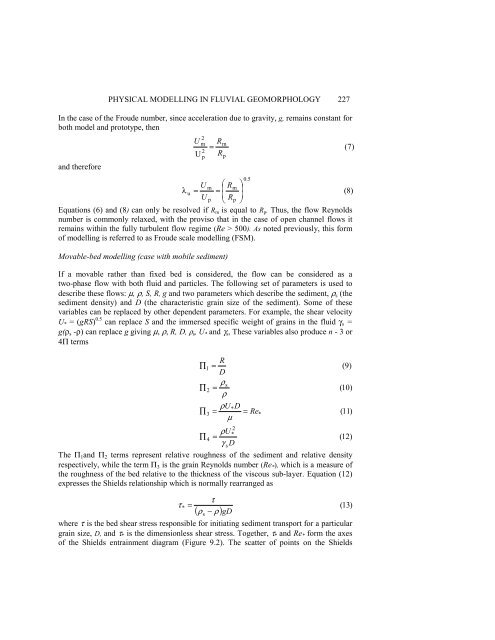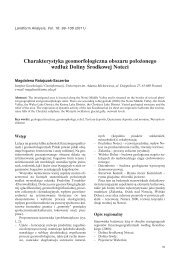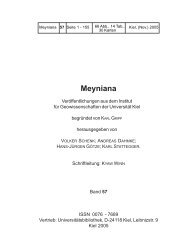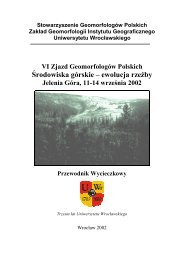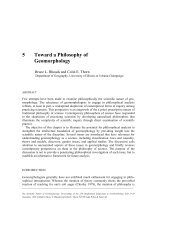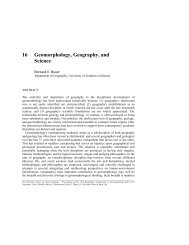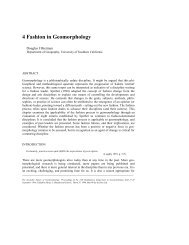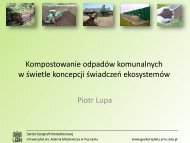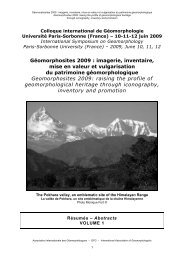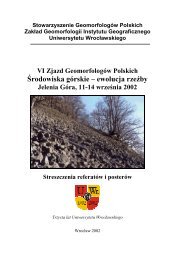Physical Modelling in Fluvial Geomorphology
Physical Modelling in Fluvial Geomorphology
Physical Modelling in Fluvial Geomorphology
You also want an ePaper? Increase the reach of your titles
YUMPU automatically turns print PDFs into web optimized ePapers that Google loves.
PHYSICAL MODELLING IN FLUVIAL GEOMORPHOLOGY 227<br />
In the case of the Froude number, s<strong>in</strong>ce acceleration due to gravity, g, rema<strong>in</strong>s constant for<br />
both model and prototype, then<br />
and therefore<br />
2<br />
U m Rm<br />
=<br />
2<br />
U R p p<br />
0.<br />
5<br />
m m<br />
u ( 8)<br />
⎟<br />
p p<br />
Equations (6) and (8) can only be resolved if Rm is equal to Rp. Thus, the flow Reynolds<br />
number is commonly relaxed, with the proviso that <strong>in</strong> the case of open channel flows it<br />
rema<strong>in</strong>s with<strong>in</strong> the fully turbulent flow regime (Re > 500). As noted previously, this form<br />
of modell<strong>in</strong>g is referred to as Froude scale modell<strong>in</strong>g (FSM).<br />
⎟<br />
U ⎛ ⎞<br />
⎜<br />
R<br />
λ = =<br />
U ⎜<br />
⎝<br />
R<br />
⎠<br />
Movable-bed modell<strong>in</strong>g (case with mobile sediment)<br />
If a movable rather than fixed bed is considered, the flow can be considered as a<br />
two-phase flow with both fluid and particles. The follow<strong>in</strong>g set of parameters is used to<br />
describe these flows: µ, ρ, S, R, g and two parameters which describe the sediment, ρs (the<br />
sediment density) and D (the characteristic gra<strong>in</strong> size of the sediment). Some of these<br />
variables can be replaced by other dependent parameters. For example, the shear velocity<br />
U* = (gRS) 0.5 can replace S and the immersed specific weight of gra<strong>in</strong>s <strong>in</strong> the fluid γs =<br />
g(ρs -ρ) can replace g giv<strong>in</strong>g µ, ρ, R, D, ρs, U* and γs, These variables also produce n - 3 or<br />
4Π terms<br />
The Π1and Π2 terms represent relative roughness of the sediment and relative density<br />
respectively, while the term Π3 is the gra<strong>in</strong> Reynolds number (Re*), which is a measure of<br />
the roughness of the bed relative to the thickness of the viscous sub-layer. Equation (12)<br />
expresses the Shields relationship which is normally rearranged as<br />
τ =<br />
*<br />
∏<br />
∏<br />
∏<br />
∏<br />
where τ is the bed shear stress responsible for <strong>in</strong>itiat<strong>in</strong>g sediment transport for a particular<br />
gra<strong>in</strong> size, D, and τ* is the dimensionless shear stress. Together, τ* and Re* form the axes<br />
of the Shields entra<strong>in</strong>ment diagram (Figure 9.2). The scatter of po<strong>in</strong>ts on the Shields<br />
1<br />
2<br />
3<br />
4<br />
R<br />
=<br />
D<br />
ρs<br />
=<br />
ρ<br />
ρU*<br />
D<br />
= = Re<br />
µ<br />
s<br />
2<br />
*<br />
ρU<br />
=<br />
γ D<br />
( ρ − ρ )<br />
s<br />
τ<br />
gD<br />
*<br />
( 7)<br />
( 9)<br />
( 10)<br />
( 11)<br />
( 12)<br />
( 13)


